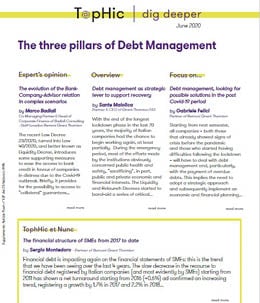-
Transactional advisory services
Find out more about the transactional advisory services of Grant Thornton Financial Advisory Services
-
Valuations
Find out more about the valuations services of Grant Thornton Financial Advisory Services
-
Mergers and acquisitions
Find out more about the merger and acquisition services of Grant Thornton Financial Advisory Services
-
Forensic and investigation services
Find out more about the forensic and investigation services of Grant Thornton Financial Advisory Services
-
Recovery & reorganisation
Find out more about the Recovery & reorganisation services of Grant Thornton Financial Advisory Services
-
Business risk services
Find out more about the business risk services of Grant Thornton Financial Advisory Services
-
Business consulting
Find out more about the business consulting services of Grant Thornton Financial Advisory Services
-
Capital market
Capital market
-
Corporate and business tax
Find out more about our corporate and business tax services.
-
Direct international tax
Find out more about our direct international tax services.
-
Global mobility services
Find out more about our global mobility services.
-
Indirect international tax
Find out more about our indirect international tax services.
-
Transfer pricing
Find out more about our transfer pricing services.
-
Litigation
Our lawyers and accountants can manage all defense measures provided not only by the Italian law, but also by EU regulations and conventions
-
Family business
Find out more about our Family business services.
-
Legal
The client can be assisted in every need and with the same care both on important operations or disputes and on simple matters

-
Back office outsourcing
Find out more about our Back office outsourcing services
-
Business process outsourcing
Find out more about our business process outsourcing services.
-
Compilation of financial statements
Find out more about our compilation of financial statements services.
-
Tax compliance
Find out more about our tax compliance services.
-
Electronic invoicing
Find out more about our electronic invoicing services
-
Electronic storage
Electronic storage is an archiving procedure that guarantees the legal validity of a digitally stored electronic document
-
Revaluation of corporate assets
Find out your civil and fiscal revaluation of tangible, intangible and financial assets
-
Payroll
Complete and customized payroll service, integrated with digital solutions and compliant with Italian and international regulations.
-
Labor consultancy
We help Italian and international companies manage all aspects of their workforce.
-
HR & Payroll Advisory Services
We review contracts, payroll, and risks for extraordinary transactions and we assess tax, labor, and safety risks in outsourcing contracts.
-
Extended services
We provide integrated digital tools to simplify HR management.
-
HR Infinity Portal
The HR Infinity Portal is Zucchetti’s platform designed to centralize communication between the company and its employees.
-
Cybersecurity
GT Digital helps clients structure information security management internal functions, also through partially or totally outsourced functions
-
Agile and Programme Management
GT Digital provides support in the adoption and implementation of different portfolio management
-
Robotic Process Automation
Our “BOT Farm” can rely on digital workers able to help clients in routine activities, allowing employees to deal with more added-value activities
-
Data strategy and management
GT Digital can support clients in seizing the opportunities offered by Big Data, from the definition of strategies to the implementation of systems
-
Enterprise Resource Planning
We support clients in selecting the most appropriate ERP System according to their specific needs, helping them also understand licensing models
-
IT strategy
GT Digital supports clients in making strategic choices, identifying innovation opportunities, comparing themselves with competitors
-
IT service management
We can support with software selection and with the implementation of dedicated tools for the management of ICT processes
-
DORA and NIS 2
The entry into force of the DORA Regulation and NIS2 represents a major step towards the creation of a harmonised regulatory framework
With the end of the longest “lock-down” phase in the last 70 years, the majority of Italian companies had the chance to begin working again, at least partially.
During the emergency period, most of the efforts made by the institutions obviously concerned public health and safety, "sacrificing", in part, public and private economic and financial interests.
The Liquidity and Relaunch Decrees started to band-aid a series of critical issues thanks, above all, to the establishment of various types of moratoriums such as, firstly, fiscal and banking postponements.
However, the technical timing of enforcement of some measures has proved to be longer than expected and, in some cases, not consistent with the timing needed to face the crisis.
What will happen now?
It is a widespread opinion, even among the highest international levels, that the real test-bed for companies will be in the second half of 2020, in the so-called "post-Covid" period, i.e. with the restarting of operating activities and, above all, with the end of the moratoriums that will inevitably worsen companies’ unbalanced cash flows and consequently weaken assets.
As usual, the time factor is a key element for implementing adequate financial policies. The ability to timely interact with banking and financial partners is fundamental for companies that want to overcome this period, anticipating the economic dynamics to be faced in markets that, since the crisis, have extremely changed.
Consequently, companies will need to show banks and shareholders how they will face these dynamics, even using diverse financial instruments. Banks, if properly informed, could not avoid accompanying companies in this new challenge, aware that, after this moment, enormous opportunities will open up to the readies, soundest and most innovative players.
Here is when the debt advisor comes in. The debt advisor is the one who reconciles the needs of banking institutions with the new value propositions companies elaborate, justifying their requirements and demonstrating their validity.
Indeed, through the financing memorandum, the debt advisor concentrates contingency plan and business plan in one unique document, duly “translated” in a language that financial backers immediately understand, clearly illustrating how the cash flows the company will generate in the coming years of activity will remunerate debt and venture capital.
From tomorrow onwards, the far-sightedness of many companies shall be measured considering the time needed to implement those strategies compared to the time needed to issue a new Decree!


